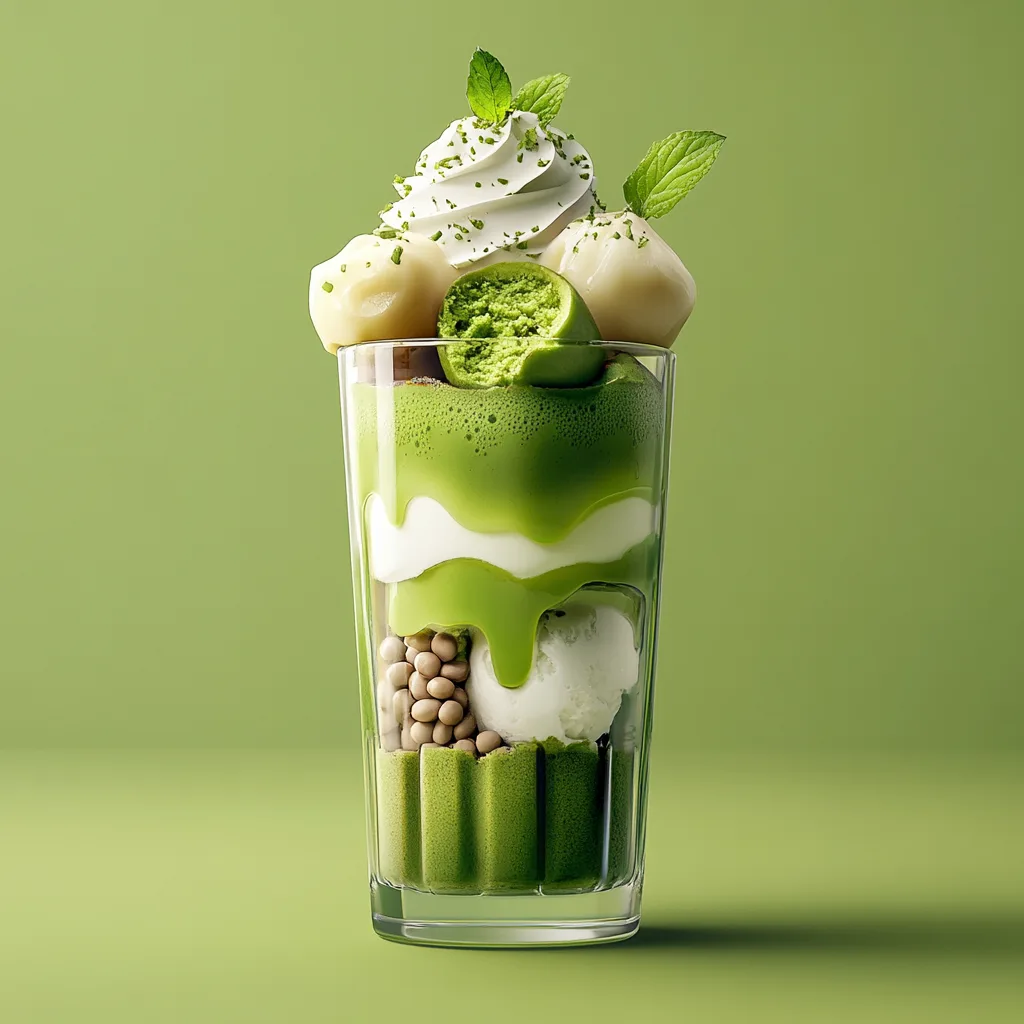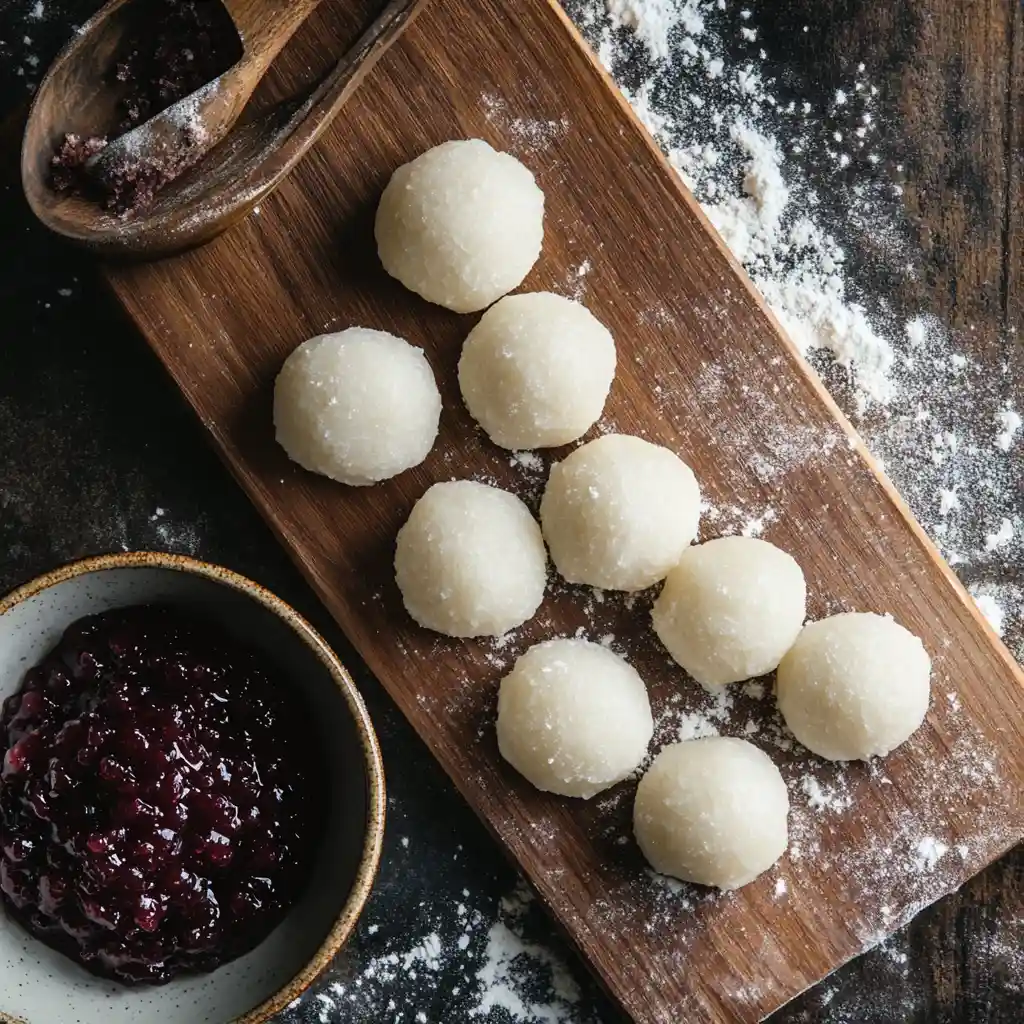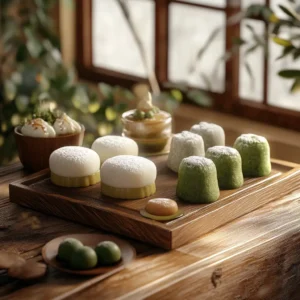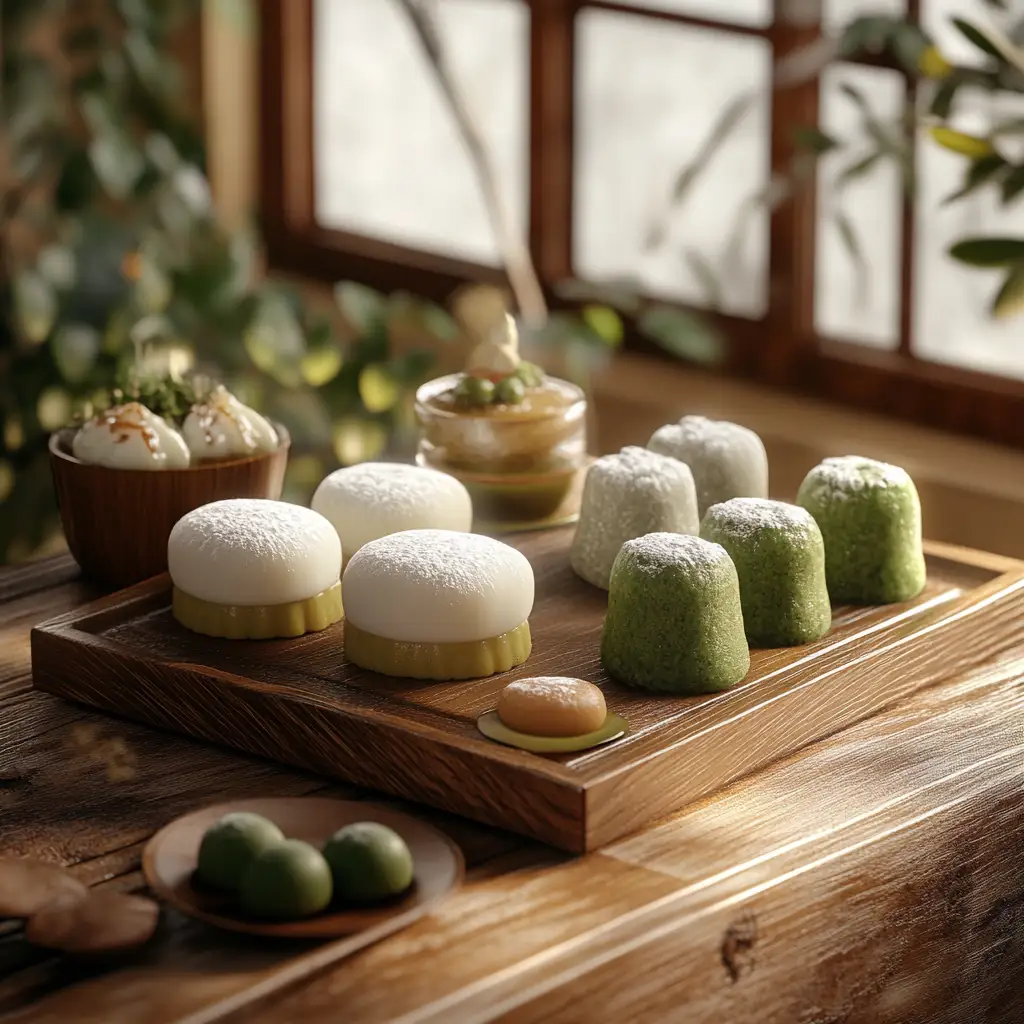Table of Contents
Japanese desserts are a delightful combination of artistry, tradition, and flavor that captivate food lovers around the globe. From chewy mochi to fluffy Japanese cheesecakes, these treats are more than just desserts, they’re a cultural experience. With their unique textures, seasonal ingredients, and meticulous presentation, Japanese desserts offer a refreshing alternative to conventional sweets. Whether you’re indulging in a bowl of an-mitsu or savoring a piece of wagashi with matcha tea, each bite tells a story of Japan’s rich culinary heritage. In this article, we’ll explore the fascinating world of Japanese desserts, covering their history, popular varieties, regional specialties, and even a recipe to try at home. Ready to dive into this sweet journey? Let’s begin!
What Are Japanese Desserts?
What Makes Japanese Desserts Unique?
Japanese desserts stand out for their emphasis on natural flavors, delicate sweetness, and artistic presentation. Unlike many Western desserts that rely heavily on sugar and butter, Japanese desserts prioritize subtle sweetness and often use seasonal ingredients like matcha (green tea powder), azuki beans (red beans), sweet potatoes, and chestnuts.
Textures play a huge role, too. Think of the soft chewiness of mochi, the light airiness of soufflé pancakes, or the smooth, jelly-like consistency of yokan. These desserts are not just about satisfying a sweet tooth, they’re about indulging all your senses. From the pastel hues of sakura mochi to the intricate designs on traditional wagashi, Japanese desserts are truly edible art.
Another fascinating aspect is the cultural significance attached to these treats. Many Japanese desserts are tied to festivals or rituals, such as sakura mochi for cherry blossom season or kashiwa mochi for Children’s Day. They’re more than food, they’re part of Japan’s heritage.
A Brief History of Japanese Sweets
The history of Japanese sweets dates back to the introduction of sugar during the Nara period (710–794). Before that, desserts were typically made with natural sweeteners like honey and fruits. The arrival of sugar transformed Japanese confectionery, giving birth to traditional sweets known as wagashi.
Wagashi gained prominence during the Edo period (1603–1868), particularly with the rise of tea ceremonies. These elegant confections were carefully crafted to complement the bitter taste of matcha, focusing on harmony and balance.
Fast forward to modern times, Japanese desserts have evolved to include influences from the West, leading to hybrid creations like Japanese cheesecakes and melon pan. Yet, even with these adaptations, the essence of Japanese desserts, delicate flavors, aesthetics, and cultural significance, remains intact.
Traditional Japanese Desserts
5 Classic Japanese Desserts You Need to Try
Japanese desserts have a timeless charm, with recipes passed down through generations. They’re rooted in tradition and offer a glimpse into Japan’s history and culture. Let’s dive into five of the most iconic traditional Japanese desserts you absolutely need to try.
1. Mochi – The Iconic Chewy Delight
Mochi, made from glutinous rice, is the poster child of Japanese desserts. Its chewy texture and subtle sweetness make it incredibly versatile. You’ll find it in various forms, from daifuku (filled with red bean paste) to warabimochi (coated with kinako, or roasted soybean flour). Mochi is also a staple during New Year celebrations in Japan, symbolizing health and good fortune.
2. Dorayaki – Sweet Pancake Sandwiches
Dorayaki consists of two fluffy pancakes sandwiched together with a filling of sweet red bean paste. It’s a favorite snack among kids and adults alike, made famous by the beloved Japanese cartoon character Doraemon. Some modern variations include fillings like custard, chocolate, or even matcha cream, giving a playful twist to this classic treat.
3. Anmitsu – A Refreshing Dessert Bowl
If you’re looking for a refreshing dessert, anmitsu is perfect. This delightful bowl features cubes of agar jelly, sweet azuki beans, fresh fruits, and a drizzle of black sugar syrup (kuromitsu). It’s a summer favorite in Japan, offering a medley of textures and flavors in every bite.
4. Taiyaki – The Fish-Shaped Pastry
Taiyaki is a fish-shaped cake traditionally filled with red bean paste, though modern fillings like custard, chocolate, or cheese are also popular. It’s a popular street food in Japan, perfect for grabbing on the go. The crispy exterior and soft, warm filling make it a comfort food favorite.
5. Yokan – A Gelatinous Sweet Treat
Yokan is a jelly-like confection made with red bean paste, agar, and sugar. It’s usually served in rectangular blocks and is known for its long shelf life. Perfectly paired with green tea, this dessert is often enjoyed during tea ceremonies.
Modern Japanese Desserts
5 Popular Contemporary Japanese Desserts
Japan’s dessert scene has evolved to embrace modern trends while still honoring tradition. Here are five contemporary Japanese desserts that blend creativity with irresistible flavors.
1. Matcha Parfaits and Crepes

Matcha has taken the dessert world by storm, and Japan is no exception. Matcha parfaits are layered with matcha ice cream, whipped cream, mochi, and sweet beans, creating a beautifully balanced dessert. Crepes, on the other hand, are often rolled up with matcha cream and fruits, making for a portable, Instagram-worthy treat.
2. Japanese Cheesecake – Light and Fluffy Perfection
Japanese cheesecake is a cloud-like dessert that melts in your mouth. Unlike its denser Western counterpart, this version is light, airy, and subtly sweet. Its unique texture comes from the addition of meringue, making it feel like you’re eating a slice of heaven.
3. Melon Pan – Sweet Bread with a Crunchy Top
Melon pan is a sweet bread topped with a layer of cookie dough, giving it a crunchy crust and soft interior. Despite its name, it doesn’t always contain melon flavor, it’s named for its appearance, which resembles a melon’s rind. Pair it with a cup of coffee for the ultimate afternoon snack.
4. Parfait Sundaes – A Perfect Blend of East and West
Japanese parfait sundaes are a fusion of traditional and Western flavors. Think layers of matcha ice cream, fresh fruit, sweet beans, and cornflakes for an unexpected crunch. Each spoonful is a delightful mix of textures and tastes, making it a favorite in Japanese dessert cafés.
5. Japanese Soufflé Pancakes – The Viral Sensation
If you’ve scrolled through Instagram, you’ve likely seen videos of jiggly Japanese soufflé pancakes. These thick, fluffy pancakes are made by whipping egg whites into a meringue and cooking them slowly for maximum fluffiness. Topped with syrup, whipped cream, or fresh berries, they’re the epitome of indulgence.
Recipe 🌟 – How to Make the Perfect Mochi

A Sweet Dive into Japanese Desserts
Mochi is one of the most iconic Japanese desserts and has been enjoyed in Japan for centuries. It’s made from glutinous rice, pounded until it transforms into a smooth, sticky dough, and can be shaped into endless variations. Whether filled with sweet red bean paste or enjoyed as a topping on your favorite desserts, mochi is a true representation of Japan’s dedication to culinary artistry. Here’s a simple recipe to create this chewy delight at home!
Ingredients 🛒
- 1 cup glutinous rice flour (e.g., shiratamako) 🌾
- 3/4 cup water 💧
- 1/4 cup sugar 🍬
- Cornstarch for dusting 🍚
- Optional fillings: Sweet red bean paste (anko), matcha powder 🍵, or even Nutella for a fusion twist.
Directions 👩🍳
- Mix the batter: Combine the glutinous rice flour, water, and sugar in a microwave-safe bowl. Stir until smooth and lump-free.
- Cook the batter: Microwave the mixture for 2 minutes. Remove, stir thoroughly, and microwave for another 1 minute until the dough becomes sticky and translucent.
- Prepare the workspace: Dust a clean surface with cornstarch to prevent sticking.
- Shape the mochi: Once cool enough to handle, scoop small portions of the dough and flatten them into circles. Place a small amount of filling in the center, then carefully seal the edges to form a ball.
- Final touches: Roll the mochi lightly in cornstarch to coat. Serve immediately or store in an airtight container.
Tips and Variations 🌟
- For a colorful twist, add natural food coloring like matcha (green), beetroot powder (pink), or purple yam powder.
- Want a fruity spin? Try stuffing your mochi with fresh strawberries or mango slices!
- If you’re feeling adventurous, use this recipe to make mochi ice cream by wrapping the dough around small scoops of ice cream.
For more delicious dessert ideas, check out our Ultimate Guide to Asian Desserts!
Regional Japanese Desserts
Regional Specialties: Desserts from Across Japan
Japan’s culinary landscape is as diverse as its regions, and Japanese desserts are no exception. Each area of Japan boasts its own unique sweet treats, many of which are deeply tied to local ingredients and traditions. Let’s take a journey across Japan and explore its regional specialties.
1. Tokyo’s Famous Tokyo Banana
A true symbol of Tokyo, Tokyo Banana is a soft sponge cake filled with creamy banana custard. This souvenir-friendly dessert has gained global recognition for its cute designs and delectable flavor. Next time you’re in Tokyo, be sure to grab a box!
2. Hokkaido’s Creamy Milk Desserts
Known for its rich dairy products, Hokkaido is famous for creamy desserts like soft serve ice cream and cheesecake. The region’s butter cookies, called Shiroi Koibito, are another must-try treat that pairs perfectly with tea or coffee.
3. Kyoto’s Matcha-based Desserts
Kyoto, the heart of Japan’s tea culture, offers some of the best matcha-based Japanese desserts. From matcha parfaits to yatsuhashi (a sweet made with cinnamon and glutinous rice flour), Kyoto’s desserts are a tea lover’s dream.
4. Okinawa’s Tropical Sweets
Okinawa, Japan’s southernmost region, is renowned for tropical flavors. Treats like beni imo tart (made from purple sweet potato) and sata andagi (Okinawan-style doughnuts) reflect the island’s unique culinary identity.
Celebrating Diversity in Japanese Desserts
From Hokkaido to Okinawa, Japan’s regional specialties showcase the country’s creativity and respect for local ingredients. Each bite tells a story of tradition, innovation, and regional pride. Curious to learn more about Japanese food culture? Check out this insightful Japanese Desserts Guide on AllRecipes for more inspiration!
Japanese Desserts for Festive Occasions
Japanese culture is rich with festivals, and each celebration comes with its own delightful Japanese desserts. These sweets aren’t just treats; they’re symbols of joy, tradition, and togetherness. Let’s explore the most popular desserts tied to Japan’s vibrant festivals.
1. Sakura Mochi for Cherry Blossom Season
Imagine sitting under blooming cherry trees, the petals gently falling like snowflakes, and enjoying a pastel pink sakura mochi. This traditional dessert is made with sweet glutinous rice wrapped in a pickled cherry leaf, giving it a unique sweet-and-salty flavor. It’s a staple during the Hanami festival, where people gather to admire cherry blossoms.
2. Kashiwa Mochi for Children’s Day
On Children’s Day, families celebrate their children’s health and happiness with kashiwa mochi. This mochi is filled with sweet red bean paste and wrapped in an oak leaf, symbolizing strength and longevity. It’s not just delicious, it’s a bite-sized reminder of the importance of family.
3. Seasonal Wagashi for Tea Ceremonies
Tea ceremonies are integral to Japanese culture, and so are the desserts that accompany them. Seasonal wagashi, such as namagashi (soft sweets) or higashi (dry sweets), are meticulously crafted to reflect the beauty of nature during that time of year. These desserts are as much about aesthetics as they are about flavor
Japanese Desserts You Can Try at Restaurants
While homemade desserts have their charm, Japanese restaurants and dessert cafés offer unique creations that are hard to replicate at home. From authentic dishes to innovative spins, here’s what you should look out for when dining out.
1. Authentic Kaiseki Desserts
Kaiseki dining is Japan’s haute cuisine, and its desserts are nothing short of art. Served at the end of a multi-course meal, these delicate sweets often feature ingredients like matcha, black sesame, and yuzu. Kaiseki desserts are small but impactful, offering a perfect balance of flavors to conclude the dining experience.
2. Japanese Dessert Cafés and Sweet Shops
In Japan, dessert cafés are a world of their own. You’ll find fluffy soufflé pancakes, matcha parfaits, and taiyaki filled with custard or chocolate. Many cafés put their own creative spin on Japanese desserts, turning traditional recipes into Instagram-worthy delights. One must-try is the honey toast, thick, buttery bread topped with ice cream, fruits, and syrup.
Indulge in the Experience
Trying Japanese desserts at a restaurant or café is more than just a meal, it’s an experience. The presentation, the ambiance, and the care that goes into each dish make it unforgettable. Don’t forget to explore dessert menus on your next visit to a Japanese restaurant, you might discover a new favorite!

Perfect Mochi
Equipment
- Microwave-Safe Bowl
- Spoon
- Surface for dusting
Ingredients
Mochi Dough
- 1 cup glutinous rice flour (e.g., shiratamako)
- ¾ cup water
- ¼ cup sugar
For Dusting
- cornstarch for dusting
Optional Fillings
- sweet red bean paste (anko)
- matcha powder
Instructions
- Combine the glutinous rice flour, water, and sugar in a microwave-safe bowl. Stir until smooth and lump-free.
- Microwave the mixture for 2 minutes. Remove, stir thoroughly, and microwave for another 1 minute until the dough becomes sticky and translucent.
- Dust a clean surface with cornstarch to prevent sticking.
- Once cool enough to handle, scoop small portions of the dough and flatten them into circles.
- Place a small amount of filling in the center, then carefully seal the edges to form a ball.
- Roll the mochi lightly in cornstarch to coat. Serve immediately or store in an airtight container.
Notes
FAQs About Japanese Desserts
Japanese desserts are intriguing, aren’t they? Whether it’s their unique ingredients or their cultural significance, people often have questions about them. Let’s tackle some of the most common ones!
What Is Japan’s Most Popular Dessert?
The answer varies depending on who you ask, but mochi and dorayaki often top the list. These classics are beloved for their versatility and nostalgic value. However, modern creations like Japanese soufflé pancakes and matcha parfaits have become global sensations, especially on social media.
What Is the Traditional Sweet of Japan?
Wagashi is considered the cornerstone of traditional Japanese desserts. These intricate sweets are handcrafted using ingredients like red bean paste, rice flour, and seasonal fruits. They’re often enjoyed with green tea and are designed to reflect the beauty of nature.
What Are the 9 Common Desserts in Japan?
Here’s a quick roundup of nine must-try Japanese desserts:
- Mochi
- Dorayaki
- Taiyaki
- Anmitsu
- Yokan
- Japanese cheesecake
- Matcha parfait
- Soufflé pancakes
- Melon pan
Each of these desserts showcases Japan’s knack for balancing flavors, textures, and aesthetics.
What Is a Popular Dessert in Tokyo?
Tokyo Banana is the city’s iconic dessert! This soft sponge cake filled with banana custard is a must-buy souvenir. You’ll also find unique cafés offering inventive treats like honey toast and matcha lattes.
Why Are Japanese Desserts So Unique?
Japanese desserts stand out because of their emphasis on natural flavors, delicate sweetness, and artistic presentation. They’re more than just food, they’re a sensory experience that connects you to Japanese culture and traditions.
Where Can I Buy Japanese Desserts?
You can find Japanese desserts at specialty Asian grocery stores, Japanese restaurants, and even online. If you’re traveling in Japan, be sure to visit local dessert shops and convenience stores for authentic and affordable treats.
How Healthy Are Japanese Desserts?
Compared to many Western desserts, Japanese desserts are often healthier. They use less sugar and incorporate nutritious ingredients like matcha, sweet potatoes, and azuki beans. But remember, everything in moderation!
Conclusion
Japanese desserts are so much more than sweet treats, they’re a delicious way to experience Japanese culture, history, and artistry. From traditional favorites like wagashi and mochi to modern delights like soufflé pancakes and matcha parfaits, there’s something for everyone to enjoy.
Whether you’re savoring a slice of Japanese cheesecake at a café, making mochi at home, or indulging in Tokyo Banana during your travels, each bite offers a taste of Japan’s rich culinary heritage.
So, what are you waiting for? Dive into the world of Japanese desserts, try a new recipe, visit a dessert café, or learn more about their history. The possibilities are endless, and your taste buds will thank you!

